The Role of Behaviorism Theory in Nursing Clinical Environment
VerifiedAdded on 2020/03/04
|11
|2741
|96
Essay
AI Summary
This essay critically analyzes the behaviorism learning theory and its application within the clinical environment, specifically in nursing education. The paper begins by defining behaviorism as a learning approach focused on observable behaviors and the acquisition of new behaviors based on environmental conditions, highlighting the stimulus-response model. It then explores the use of behaviorism in healthcare, including techniques like respondent and operant conditioning, positive and negative reinforcement, and behavioral contracts. The essay discusses how behaviorism can facilitate learning by promoting desired behaviors and technical skills in clinical settings. However, it also acknowledges the limitations and criticisms of this theory, such as its teacher-centered approach, potential for manipulation, focus on extrinsic rewards, and lack of creativity. The essay concludes by emphasizing the value of behaviorism in building competencies and changing behaviors through educational interventions, especially in nursing education, while also considering its one-dimensional approach. Examples of applying this theory include praising students during procedures and providing support to improve their clinical skills. The essay highlights the importance of educators in guiding students to achieve recurrent and desired learning outcomes within a nursing setting.
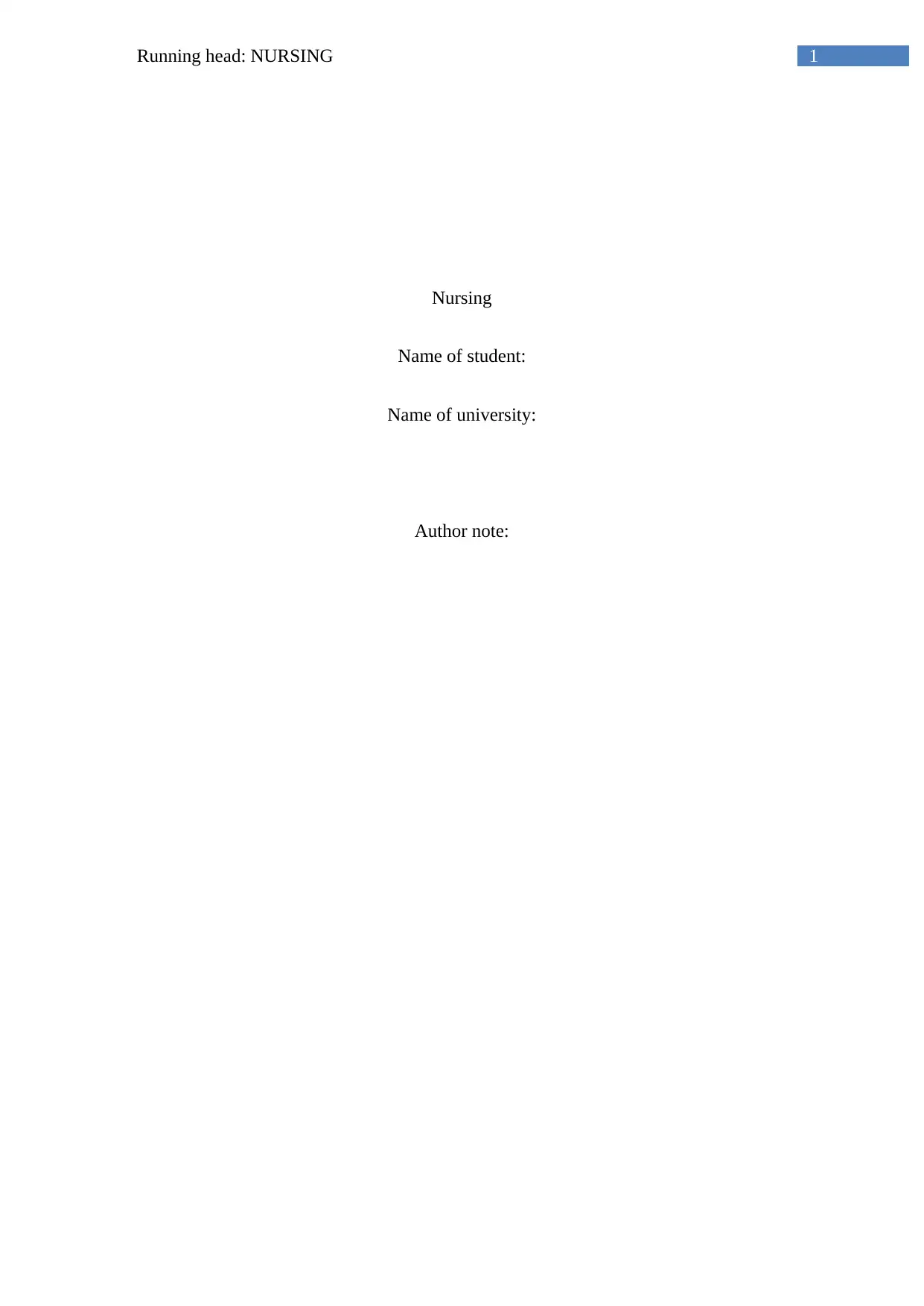
1Running head: NURSING
Nursing
Name of student:
Name of university:
Author note:
Nursing
Name of student:
Name of university:
Author note:
Paraphrase This Document
Need a fresh take? Get an instant paraphrase of this document with our AI Paraphraser
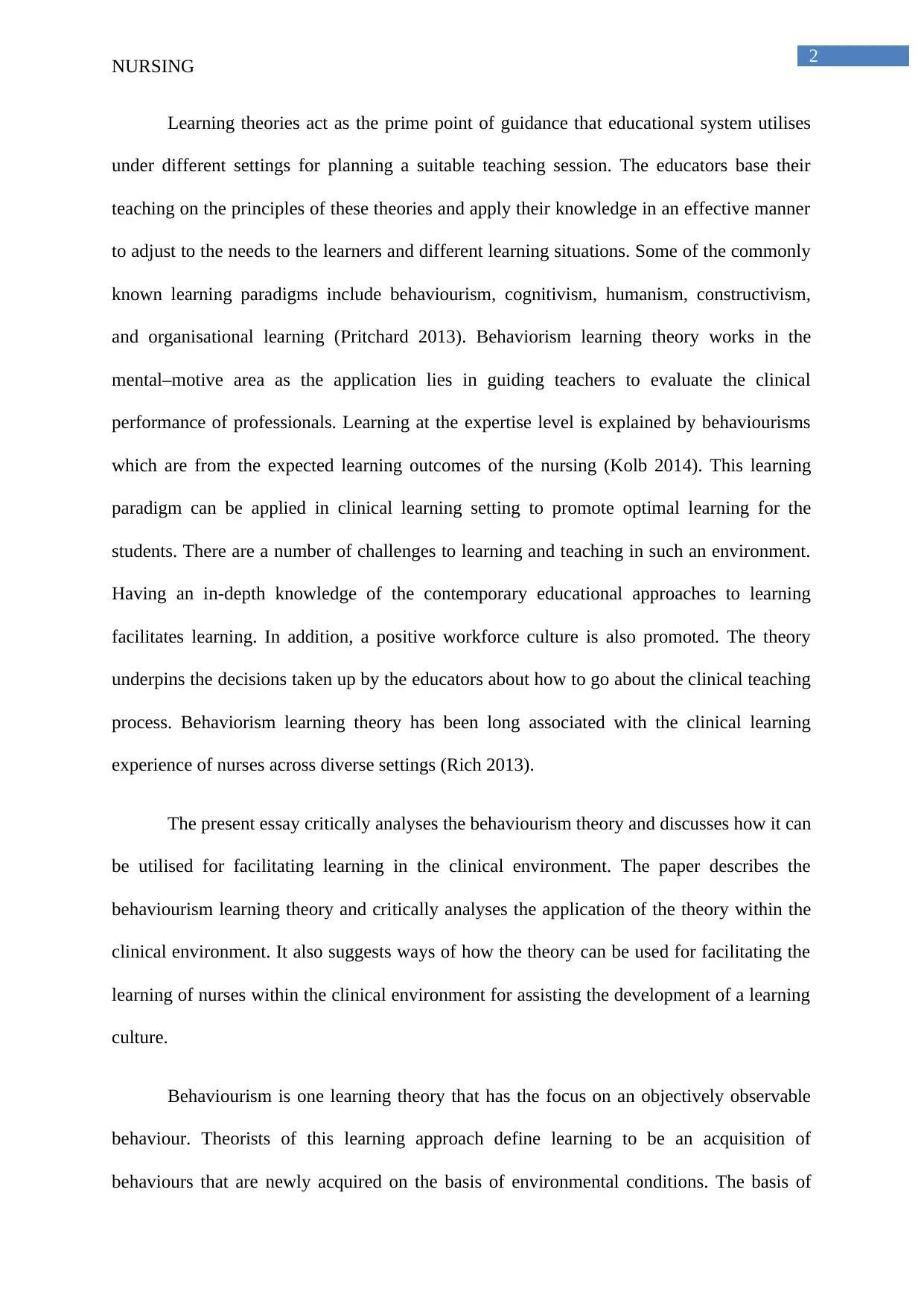
2
NURSING
Learning theories act as the prime point of guidance that educational system utilises
under different settings for planning a suitable teaching session. The educators base their
teaching on the principles of these theories and apply their knowledge in an effective manner
to adjust to the needs to the learners and different learning situations. Some of the commonly
known learning paradigms include behaviourism, cognitivism, humanism, constructivism,
and organisational learning (Pritchard 2013). Behaviorism learning theory works in the
mental–motive area as the application lies in guiding teachers to evaluate the clinical
performance of professionals. Learning at the expertise level is explained by behaviourisms
which are from the expected learning outcomes of the nursing (Kolb 2014). This learning
paradigm can be applied in clinical learning setting to promote optimal learning for the
students. There are a number of challenges to learning and teaching in such an environment.
Having an in-depth knowledge of the contemporary educational approaches to learning
facilitates learning. In addition, a positive workforce culture is also promoted. The theory
underpins the decisions taken up by the educators about how to go about the clinical teaching
process. Behaviorism learning theory has been long associated with the clinical learning
experience of nurses across diverse settings (Rich 2013).
The present essay critically analyses the behaviourism theory and discusses how it can
be utilised for facilitating learning in the clinical environment. The paper describes the
behaviourism learning theory and critically analyses the application of the theory within the
clinical environment. It also suggests ways of how the theory can be used for facilitating the
learning of nurses within the clinical environment for assisting the development of a learning
culture.
Behaviourism is one learning theory that has the focus on an objectively observable
behaviour. Theorists of this learning approach define learning to be an acquisition of
behaviours that are newly acquired on the basis of environmental conditions. The basis of
NURSING
Learning theories act as the prime point of guidance that educational system utilises
under different settings for planning a suitable teaching session. The educators base their
teaching on the principles of these theories and apply their knowledge in an effective manner
to adjust to the needs to the learners and different learning situations. Some of the commonly
known learning paradigms include behaviourism, cognitivism, humanism, constructivism,
and organisational learning (Pritchard 2013). Behaviorism learning theory works in the
mental–motive area as the application lies in guiding teachers to evaluate the clinical
performance of professionals. Learning at the expertise level is explained by behaviourisms
which are from the expected learning outcomes of the nursing (Kolb 2014). This learning
paradigm can be applied in clinical learning setting to promote optimal learning for the
students. There are a number of challenges to learning and teaching in such an environment.
Having an in-depth knowledge of the contemporary educational approaches to learning
facilitates learning. In addition, a positive workforce culture is also promoted. The theory
underpins the decisions taken up by the educators about how to go about the clinical teaching
process. Behaviorism learning theory has been long associated with the clinical learning
experience of nurses across diverse settings (Rich 2013).
The present essay critically analyses the behaviourism theory and discusses how it can
be utilised for facilitating learning in the clinical environment. The paper describes the
behaviourism learning theory and critically analyses the application of the theory within the
clinical environment. It also suggests ways of how the theory can be used for facilitating the
learning of nurses within the clinical environment for assisting the development of a learning
culture.
Behaviourism is one learning theory that has the focus on an objectively observable
behaviour. Theorists of this learning approach define learning to be an acquisition of
behaviours that are newly acquired on the basis of environmental conditions. The basis of
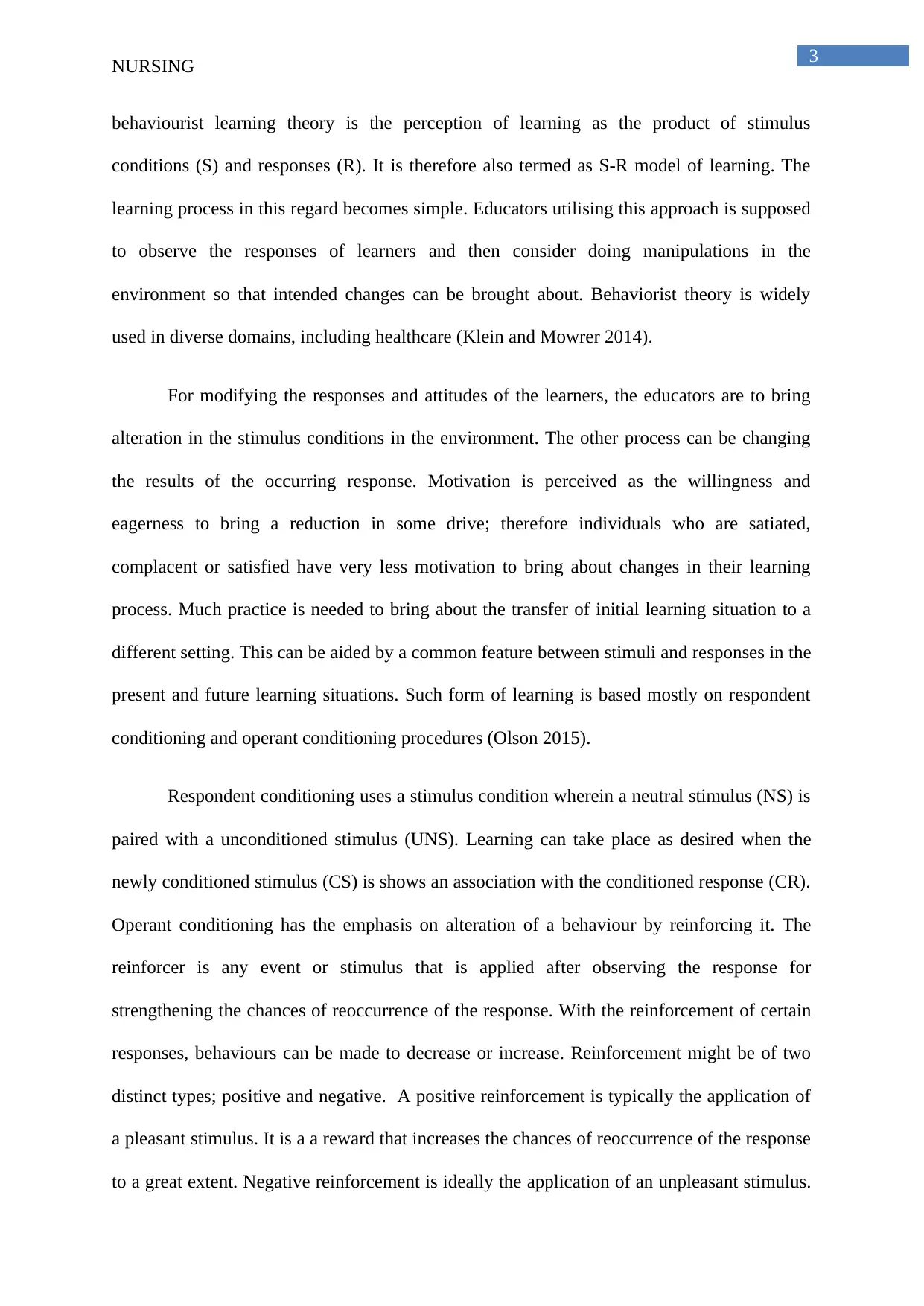
3
NURSING
behaviourist learning theory is the perception of learning as the product of stimulus
conditions (S) and responses (R). It is therefore also termed as S-R model of learning. The
learning process in this regard becomes simple. Educators utilising this approach is supposed
to observe the responses of learners and then consider doing manipulations in the
environment so that intended changes can be brought about. Behaviorist theory is widely
used in diverse domains, including healthcare (Klein and Mowrer 2014).
For modifying the responses and attitudes of the learners, the educators are to bring
alteration in the stimulus conditions in the environment. The other process can be changing
the results of the occurring response. Motivation is perceived as the willingness and
eagerness to bring a reduction in some drive; therefore individuals who are satiated,
complacent or satisfied have very less motivation to bring about changes in their learning
process. Much practice is needed to bring about the transfer of initial learning situation to a
different setting. This can be aided by a common feature between stimuli and responses in the
present and future learning situations. Such form of learning is based mostly on respondent
conditioning and operant conditioning procedures (Olson 2015).
Respondent conditioning uses a stimulus condition wherein a neutral stimulus (NS) is
paired with a unconditioned stimulus (UNS). Learning can take place as desired when the
newly conditioned stimulus (CS) is shows an association with the conditioned response (CR).
Operant conditioning has the emphasis on alteration of a behaviour by reinforcing it. The
reinforcer is any event or stimulus that is applied after observing the response for
strengthening the chances of reoccurrence of the response. With the reinforcement of certain
responses, behaviours can be made to decrease or increase. Reinforcement might be of two
distinct types; positive and negative. A positive reinforcement is typically the application of
a pleasant stimulus. It is a a reward that increases the chances of reoccurrence of the response
to a great extent. Negative reinforcement is ideally the application of an unpleasant stimulus.
NURSING
behaviourist learning theory is the perception of learning as the product of stimulus
conditions (S) and responses (R). It is therefore also termed as S-R model of learning. The
learning process in this regard becomes simple. Educators utilising this approach is supposed
to observe the responses of learners and then consider doing manipulations in the
environment so that intended changes can be brought about. Behaviorist theory is widely
used in diverse domains, including healthcare (Klein and Mowrer 2014).
For modifying the responses and attitudes of the learners, the educators are to bring
alteration in the stimulus conditions in the environment. The other process can be changing
the results of the occurring response. Motivation is perceived as the willingness and
eagerness to bring a reduction in some drive; therefore individuals who are satiated,
complacent or satisfied have very less motivation to bring about changes in their learning
process. Much practice is needed to bring about the transfer of initial learning situation to a
different setting. This can be aided by a common feature between stimuli and responses in the
present and future learning situations. Such form of learning is based mostly on respondent
conditioning and operant conditioning procedures (Olson 2015).
Respondent conditioning uses a stimulus condition wherein a neutral stimulus (NS) is
paired with a unconditioned stimulus (UNS). Learning can take place as desired when the
newly conditioned stimulus (CS) is shows an association with the conditioned response (CR).
Operant conditioning has the emphasis on alteration of a behaviour by reinforcing it. The
reinforcer is any event or stimulus that is applied after observing the response for
strengthening the chances of reoccurrence of the response. With the reinforcement of certain
responses, behaviours can be made to decrease or increase. Reinforcement might be of two
distinct types; positive and negative. A positive reinforcement is typically the application of
a pleasant stimulus. It is a a reward that increases the chances of reoccurrence of the response
to a great extent. Negative reinforcement is ideally the application of an unpleasant stimulus.
⊘ This is a preview!⊘
Do you want full access?
Subscribe today to unlock all pages.

Trusted by 1+ million students worldwide
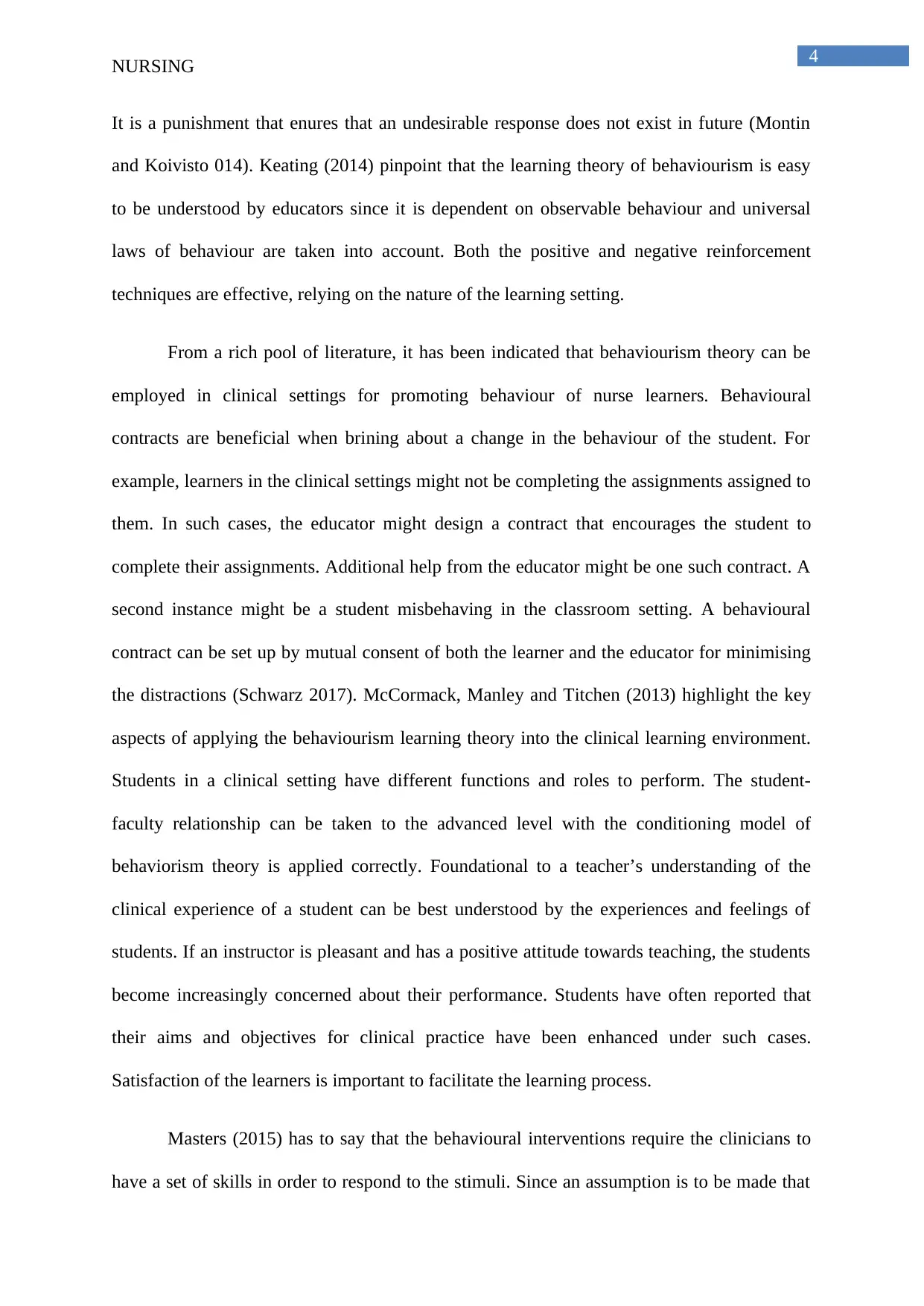
4
NURSING
It is a punishment that enures that an undesirable response does not exist in future (Montin
and Koivisto 014). Keating (2014) pinpoint that the learning theory of behaviourism is easy
to be understood by educators since it is dependent on observable behaviour and universal
laws of behaviour are taken into account. Both the positive and negative reinforcement
techniques are effective, relying on the nature of the learning setting.
From a rich pool of literature, it has been indicated that behaviourism theory can be
employed in clinical settings for promoting behaviour of nurse learners. Behavioural
contracts are beneficial when brining about a change in the behaviour of the student. For
example, learners in the clinical settings might not be completing the assignments assigned to
them. In such cases, the educator might design a contract that encourages the student to
complete their assignments. Additional help from the educator might be one such contract. A
second instance might be a student misbehaving in the classroom setting. A behavioural
contract can be set up by mutual consent of both the learner and the educator for minimising
the distractions (Schwarz 2017). McCormack, Manley and Titchen (2013) highlight the key
aspects of applying the behaviourism learning theory into the clinical learning environment.
Students in a clinical setting have different functions and roles to perform. The student-
faculty relationship can be taken to the advanced level with the conditioning model of
behaviorism theory is applied correctly. Foundational to a teacher’s understanding of the
clinical experience of a student can be best understood by the experiences and feelings of
students. If an instructor is pleasant and has a positive attitude towards teaching, the students
become increasingly concerned about their performance. Students have often reported that
their aims and objectives for clinical practice have been enhanced under such cases.
Satisfaction of the learners is important to facilitate the learning process.
Masters (2015) has to say that the behavioural interventions require the clinicians to
have a set of skills in order to respond to the stimuli. Since an assumption is to be made that
NURSING
It is a punishment that enures that an undesirable response does not exist in future (Montin
and Koivisto 014). Keating (2014) pinpoint that the learning theory of behaviourism is easy
to be understood by educators since it is dependent on observable behaviour and universal
laws of behaviour are taken into account. Both the positive and negative reinforcement
techniques are effective, relying on the nature of the learning setting.
From a rich pool of literature, it has been indicated that behaviourism theory can be
employed in clinical settings for promoting behaviour of nurse learners. Behavioural
contracts are beneficial when brining about a change in the behaviour of the student. For
example, learners in the clinical settings might not be completing the assignments assigned to
them. In such cases, the educator might design a contract that encourages the student to
complete their assignments. Additional help from the educator might be one such contract. A
second instance might be a student misbehaving in the classroom setting. A behavioural
contract can be set up by mutual consent of both the learner and the educator for minimising
the distractions (Schwarz 2017). McCormack, Manley and Titchen (2013) highlight the key
aspects of applying the behaviourism learning theory into the clinical learning environment.
Students in a clinical setting have different functions and roles to perform. The student-
faculty relationship can be taken to the advanced level with the conditioning model of
behaviorism theory is applied correctly. Foundational to a teacher’s understanding of the
clinical experience of a student can be best understood by the experiences and feelings of
students. If an instructor is pleasant and has a positive attitude towards teaching, the students
become increasingly concerned about their performance. Students have often reported that
their aims and objectives for clinical practice have been enhanced under such cases.
Satisfaction of the learners is important to facilitate the learning process.
Masters (2015) has to say that the behavioural interventions require the clinicians to
have a set of skills in order to respond to the stimuli. Since an assumption is to be made that
Paraphrase This Document
Need a fresh take? Get an instant paraphrase of this document with our AI Paraphraser
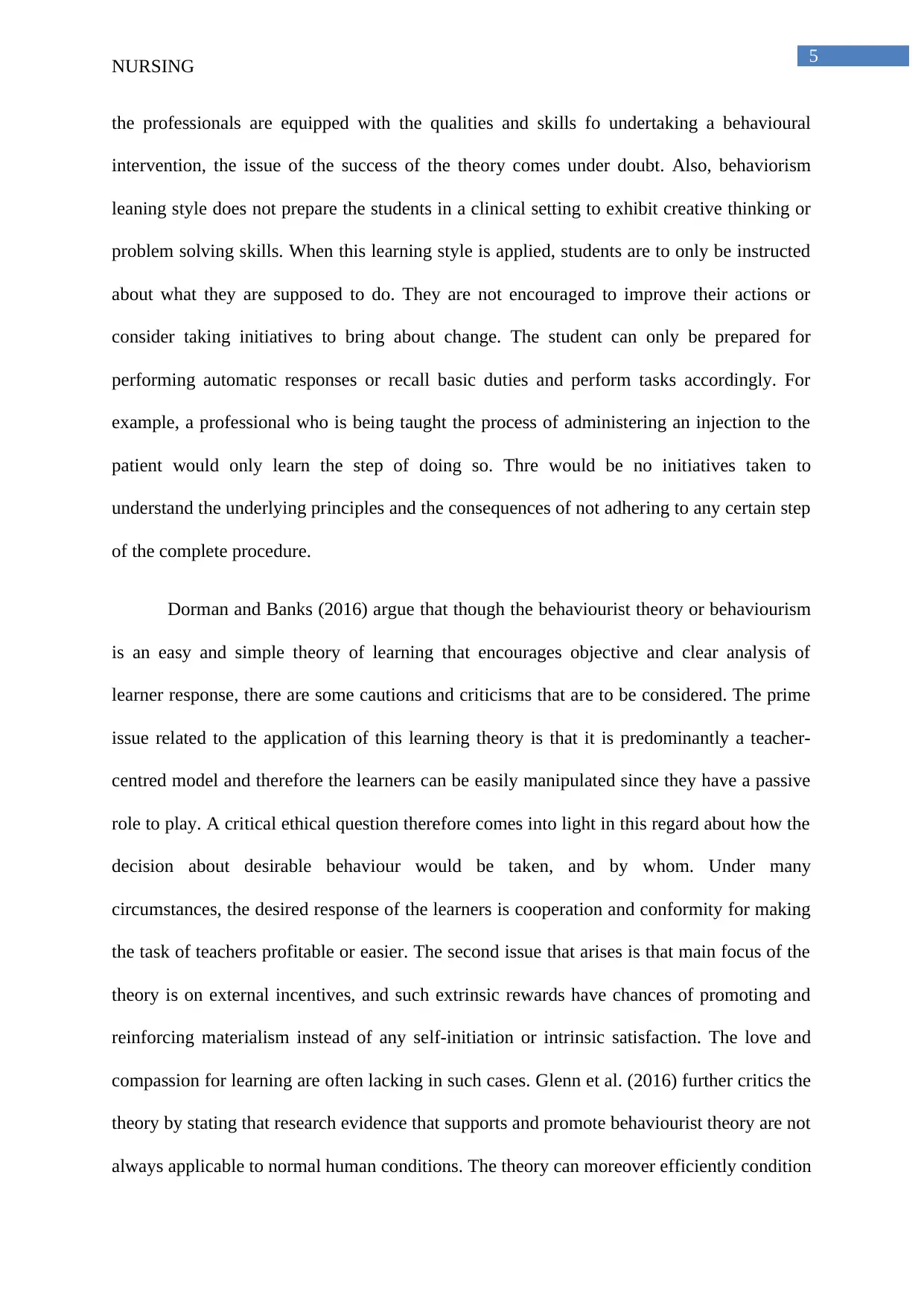
5
NURSING
the professionals are equipped with the qualities and skills fo undertaking a behavioural
intervention, the issue of the success of the theory comes under doubt. Also, behaviorism
leaning style does not prepare the students in a clinical setting to exhibit creative thinking or
problem solving skills. When this learning style is applied, students are to only be instructed
about what they are supposed to do. They are not encouraged to improve their actions or
consider taking initiatives to bring about change. The student can only be prepared for
performing automatic responses or recall basic duties and perform tasks accordingly. For
example, a professional who is being taught the process of administering an injection to the
patient would only learn the step of doing so. Thre would be no initiatives taken to
understand the underlying principles and the consequences of not adhering to any certain step
of the complete procedure.
Dorman and Banks (2016) argue that though the behaviourist theory or behaviourism
is an easy and simple theory of learning that encourages objective and clear analysis of
learner response, there are some cautions and criticisms that are to be considered. The prime
issue related to the application of this learning theory is that it is predominantly a teacher-
centred model and therefore the learners can be easily manipulated since they have a passive
role to play. A critical ethical question therefore comes into light in this regard about how the
decision about desirable behaviour would be taken, and by whom. Under many
circumstances, the desired response of the learners is cooperation and conformity for making
the task of teachers profitable or easier. The second issue that arises is that main focus of the
theory is on external incentives, and such extrinsic rewards have chances of promoting and
reinforcing materialism instead of any self-initiation or intrinsic satisfaction. The love and
compassion for learning are often lacking in such cases. Glenn et al. (2016) further critics the
theory by stating that research evidence that supports and promote behaviourist theory are not
always applicable to normal human conditions. The theory can moreover efficiently condition
NURSING
the professionals are equipped with the qualities and skills fo undertaking a behavioural
intervention, the issue of the success of the theory comes under doubt. Also, behaviorism
leaning style does not prepare the students in a clinical setting to exhibit creative thinking or
problem solving skills. When this learning style is applied, students are to only be instructed
about what they are supposed to do. They are not encouraged to improve their actions or
consider taking initiatives to bring about change. The student can only be prepared for
performing automatic responses or recall basic duties and perform tasks accordingly. For
example, a professional who is being taught the process of administering an injection to the
patient would only learn the step of doing so. Thre would be no initiatives taken to
understand the underlying principles and the consequences of not adhering to any certain step
of the complete procedure.
Dorman and Banks (2016) argue that though the behaviourist theory or behaviourism
is an easy and simple theory of learning that encourages objective and clear analysis of
learner response, there are some cautions and criticisms that are to be considered. The prime
issue related to the application of this learning theory is that it is predominantly a teacher-
centred model and therefore the learners can be easily manipulated since they have a passive
role to play. A critical ethical question therefore comes into light in this regard about how the
decision about desirable behaviour would be taken, and by whom. Under many
circumstances, the desired response of the learners is cooperation and conformity for making
the task of teachers profitable or easier. The second issue that arises is that main focus of the
theory is on external incentives, and such extrinsic rewards have chances of promoting and
reinforcing materialism instead of any self-initiation or intrinsic satisfaction. The love and
compassion for learning are often lacking in such cases. Glenn et al. (2016) further critics the
theory by stating that research evidence that supports and promote behaviourist theory are not
always applicable to normal human conditions. The theory can moreover efficiently condition
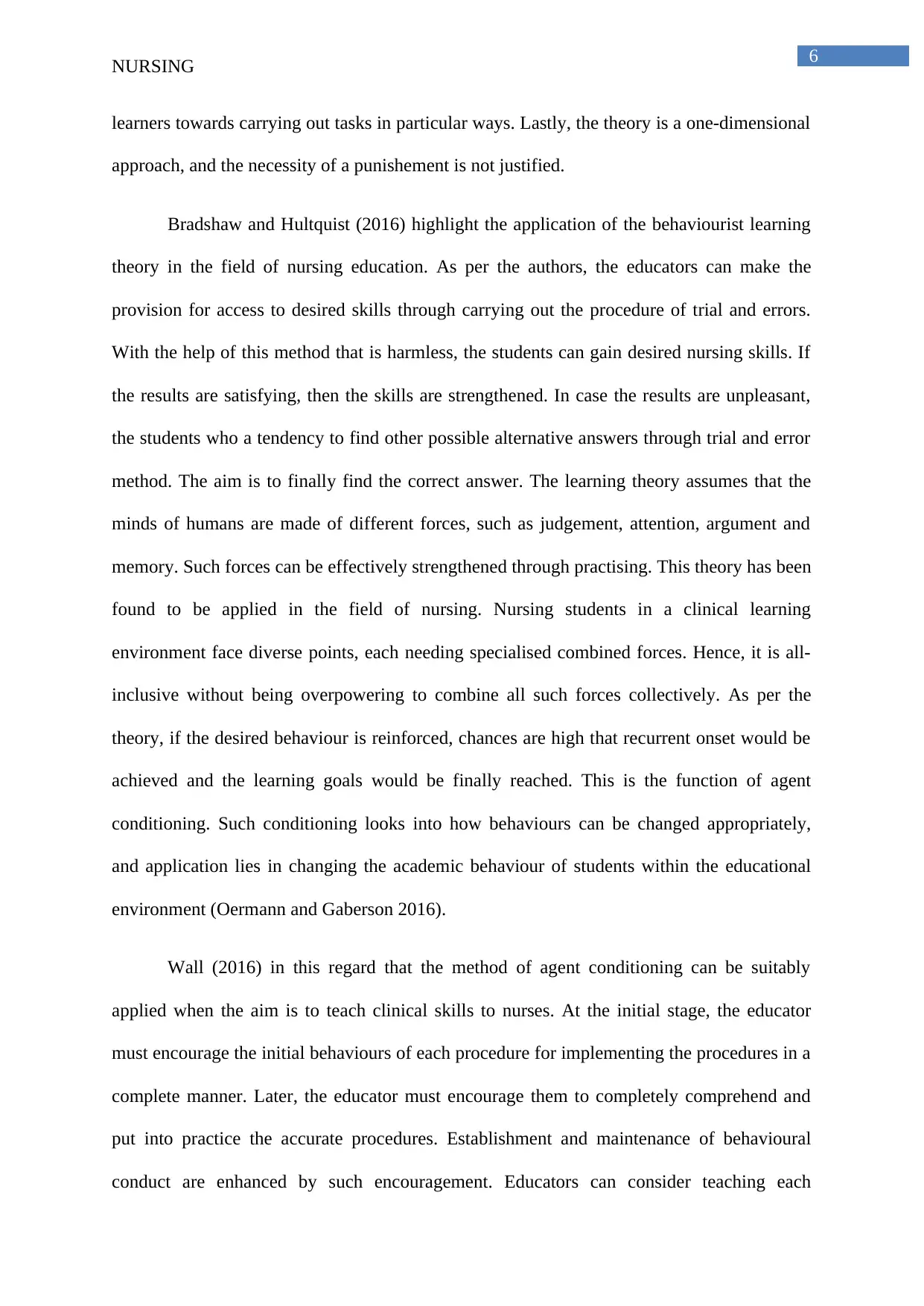
6
NURSING
learners towards carrying out tasks in particular ways. Lastly, the theory is a one-dimensional
approach, and the necessity of a punishement is not justified.
Bradshaw and Hultquist (2016) highlight the application of the behaviourist learning
theory in the field of nursing education. As per the authors, the educators can make the
provision for access to desired skills through carrying out the procedure of trial and errors.
With the help of this method that is harmless, the students can gain desired nursing skills. If
the results are satisfying, then the skills are strengthened. In case the results are unpleasant,
the students who a tendency to find other possible alternative answers through trial and error
method. The aim is to finally find the correct answer. The learning theory assumes that the
minds of humans are made of different forces, such as judgement, attention, argument and
memory. Such forces can be effectively strengthened through practising. This theory has been
found to be applied in the field of nursing. Nursing students in a clinical learning
environment face diverse points, each needing specialised combined forces. Hence, it is all-
inclusive without being overpowering to combine all such forces collectively. As per the
theory, if the desired behaviour is reinforced, chances are high that recurrent onset would be
achieved and the learning goals would be finally reached. This is the function of agent
conditioning. Such conditioning looks into how behaviours can be changed appropriately,
and application lies in changing the academic behaviour of students within the educational
environment (Oermann and Gaberson 2016).
Wall (2016) in this regard that the method of agent conditioning can be suitably
applied when the aim is to teach clinical skills to nurses. At the initial stage, the educator
must encourage the initial behaviours of each procedure for implementing the procedures in a
complete manner. Later, the educator must encourage them to completely comprehend and
put into practice the accurate procedures. Establishment and maintenance of behavioural
conduct are enhanced by such encouragement. Educators can consider teaching each
NURSING
learners towards carrying out tasks in particular ways. Lastly, the theory is a one-dimensional
approach, and the necessity of a punishement is not justified.
Bradshaw and Hultquist (2016) highlight the application of the behaviourist learning
theory in the field of nursing education. As per the authors, the educators can make the
provision for access to desired skills through carrying out the procedure of trial and errors.
With the help of this method that is harmless, the students can gain desired nursing skills. If
the results are satisfying, then the skills are strengthened. In case the results are unpleasant,
the students who a tendency to find other possible alternative answers through trial and error
method. The aim is to finally find the correct answer. The learning theory assumes that the
minds of humans are made of different forces, such as judgement, attention, argument and
memory. Such forces can be effectively strengthened through practising. This theory has been
found to be applied in the field of nursing. Nursing students in a clinical learning
environment face diverse points, each needing specialised combined forces. Hence, it is all-
inclusive without being overpowering to combine all such forces collectively. As per the
theory, if the desired behaviour is reinforced, chances are high that recurrent onset would be
achieved and the learning goals would be finally reached. This is the function of agent
conditioning. Such conditioning looks into how behaviours can be changed appropriately,
and application lies in changing the academic behaviour of students within the educational
environment (Oermann and Gaberson 2016).
Wall (2016) in this regard that the method of agent conditioning can be suitably
applied when the aim is to teach clinical skills to nurses. At the initial stage, the educator
must encourage the initial behaviours of each procedure for implementing the procedures in a
complete manner. Later, the educator must encourage them to completely comprehend and
put into practice the accurate procedures. Establishment and maintenance of behavioural
conduct are enhanced by such encouragement. Educators can consider teaching each
⊘ This is a preview!⊘
Do you want full access?
Subscribe today to unlock all pages.

Trusted by 1+ million students worldwide
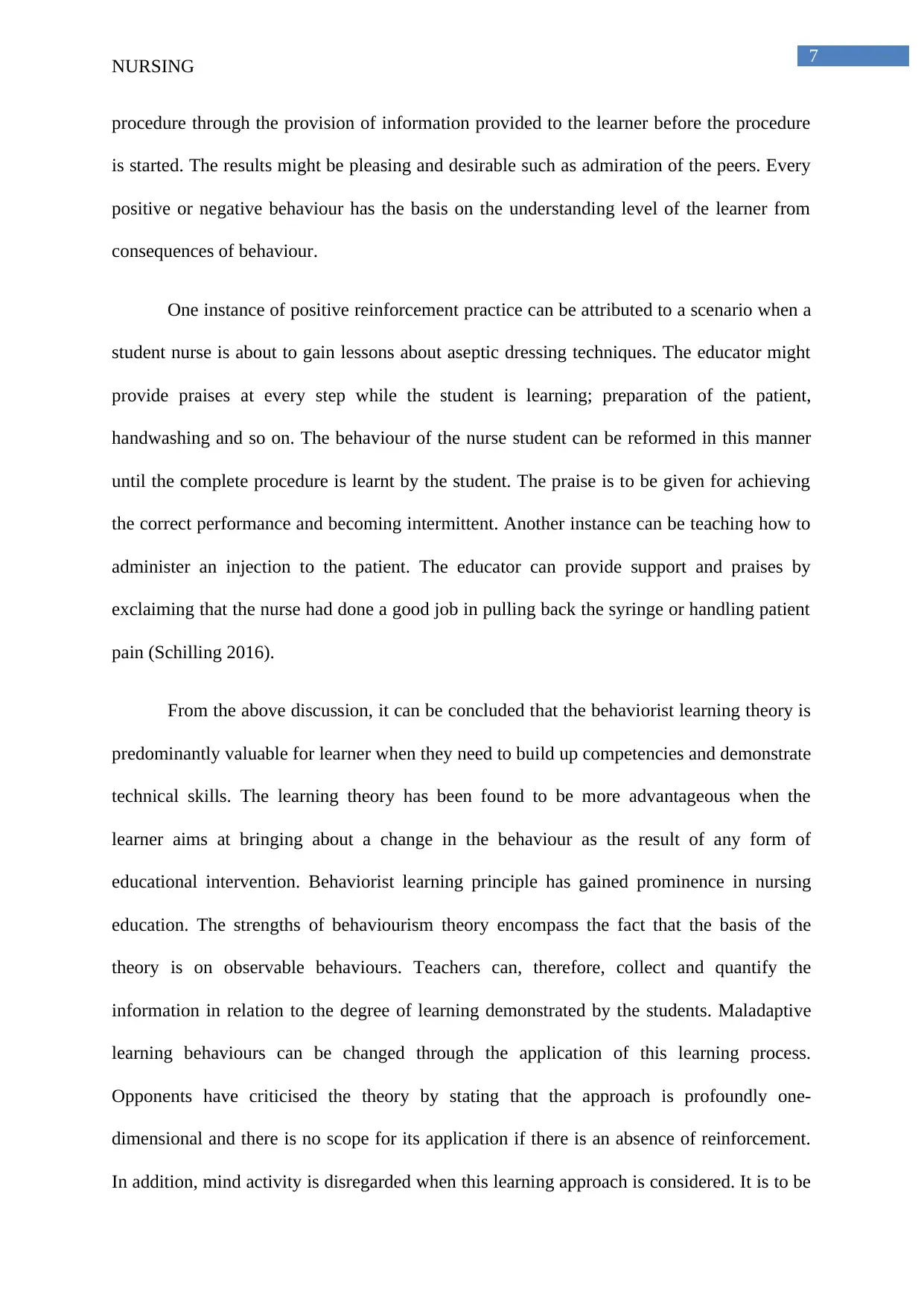
7
NURSING
procedure through the provision of information provided to the learner before the procedure
is started. The results might be pleasing and desirable such as admiration of the peers. Every
positive or negative behaviour has the basis on the understanding level of the learner from
consequences of behaviour.
One instance of positive reinforcement practice can be attributed to a scenario when a
student nurse is about to gain lessons about aseptic dressing techniques. The educator might
provide praises at every step while the student is learning; preparation of the patient,
handwashing and so on. The behaviour of the nurse student can be reformed in this manner
until the complete procedure is learnt by the student. The praise is to be given for achieving
the correct performance and becoming intermittent. Another instance can be teaching how to
administer an injection to the patient. The educator can provide support and praises by
exclaiming that the nurse had done a good job in pulling back the syringe or handling patient
pain (Schilling 2016).
From the above discussion, it can be concluded that the behaviorist learning theory is
predominantly valuable for learner when they need to build up competencies and demonstrate
technical skills. The learning theory has been found to be more advantageous when the
learner aims at bringing about a change in the behaviour as the result of any form of
educational intervention. Behaviorist learning principle has gained prominence in nursing
education. The strengths of behaviourism theory encompass the fact that the basis of the
theory is on observable behaviours. Teachers can, therefore, collect and quantify the
information in relation to the degree of learning demonstrated by the students. Maladaptive
learning behaviours can be changed through the application of this learning process.
Opponents have criticised the theory by stating that the approach is profoundly one-
dimensional and there is no scope for its application if there is an absence of reinforcement.
In addition, mind activity is disregarded when this learning approach is considered. It is to be
NURSING
procedure through the provision of information provided to the learner before the procedure
is started. The results might be pleasing and desirable such as admiration of the peers. Every
positive or negative behaviour has the basis on the understanding level of the learner from
consequences of behaviour.
One instance of positive reinforcement practice can be attributed to a scenario when a
student nurse is about to gain lessons about aseptic dressing techniques. The educator might
provide praises at every step while the student is learning; preparation of the patient,
handwashing and so on. The behaviour of the nurse student can be reformed in this manner
until the complete procedure is learnt by the student. The praise is to be given for achieving
the correct performance and becoming intermittent. Another instance can be teaching how to
administer an injection to the patient. The educator can provide support and praises by
exclaiming that the nurse had done a good job in pulling back the syringe or handling patient
pain (Schilling 2016).
From the above discussion, it can be concluded that the behaviorist learning theory is
predominantly valuable for learner when they need to build up competencies and demonstrate
technical skills. The learning theory has been found to be more advantageous when the
learner aims at bringing about a change in the behaviour as the result of any form of
educational intervention. Behaviorist learning principle has gained prominence in nursing
education. The strengths of behaviourism theory encompass the fact that the basis of the
theory is on observable behaviours. Teachers can, therefore, collect and quantify the
information in relation to the degree of learning demonstrated by the students. Maladaptive
learning behaviours can be changed through the application of this learning process.
Opponents have criticised the theory by stating that the approach is profoundly one-
dimensional and there is no scope for its application if there is an absence of reinforcement.
In addition, mind activity is disregarded when this learning approach is considered. It is to be
Paraphrase This Document
Need a fresh take? Get an instant paraphrase of this document with our AI Paraphraser
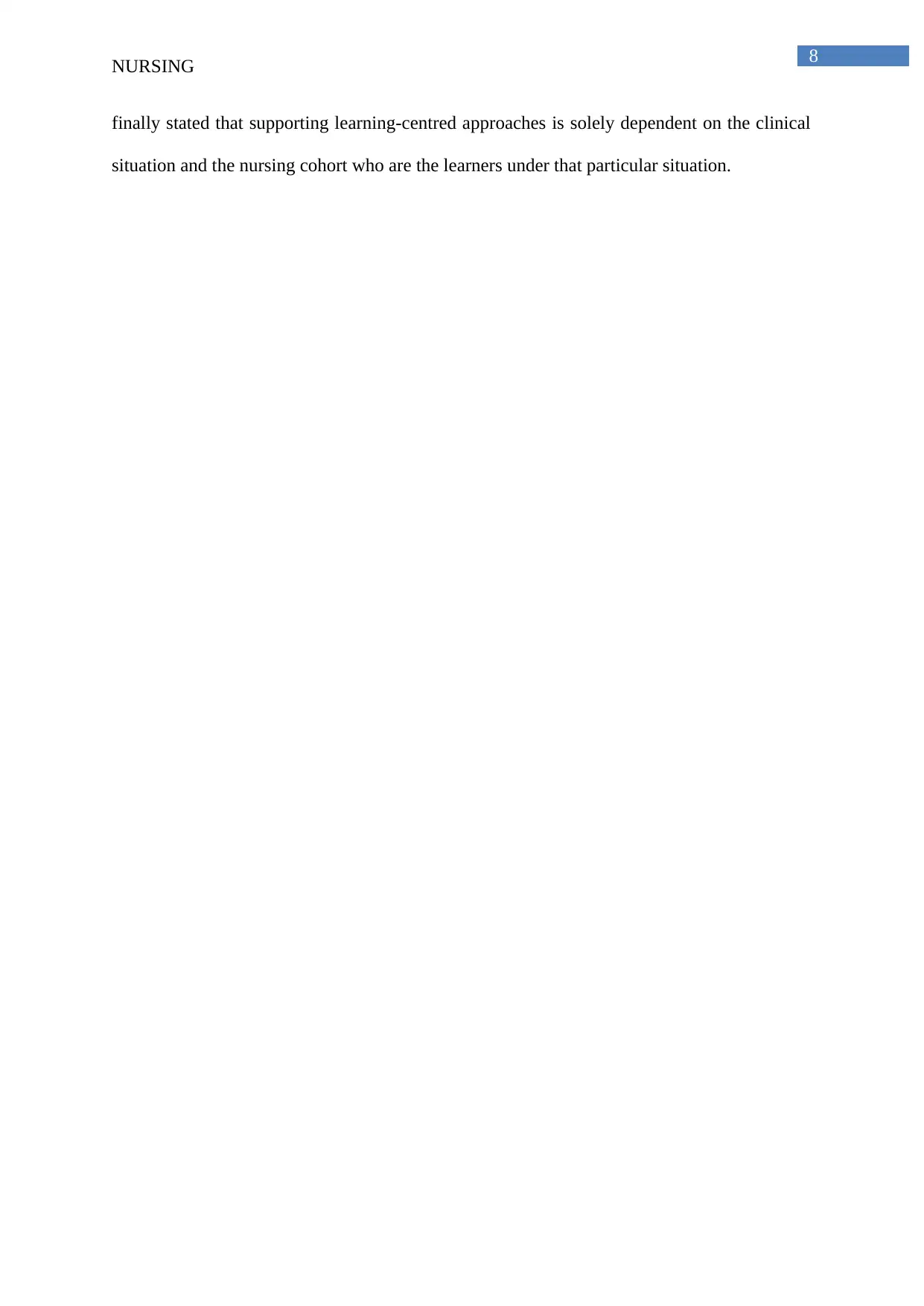
8
NURSING
finally stated that supporting learning-centred approaches is solely dependent on the clinical
situation and the nursing cohort who are the learners under that particular situation.
NURSING
finally stated that supporting learning-centred approaches is solely dependent on the clinical
situation and the nursing cohort who are the learners under that particular situation.
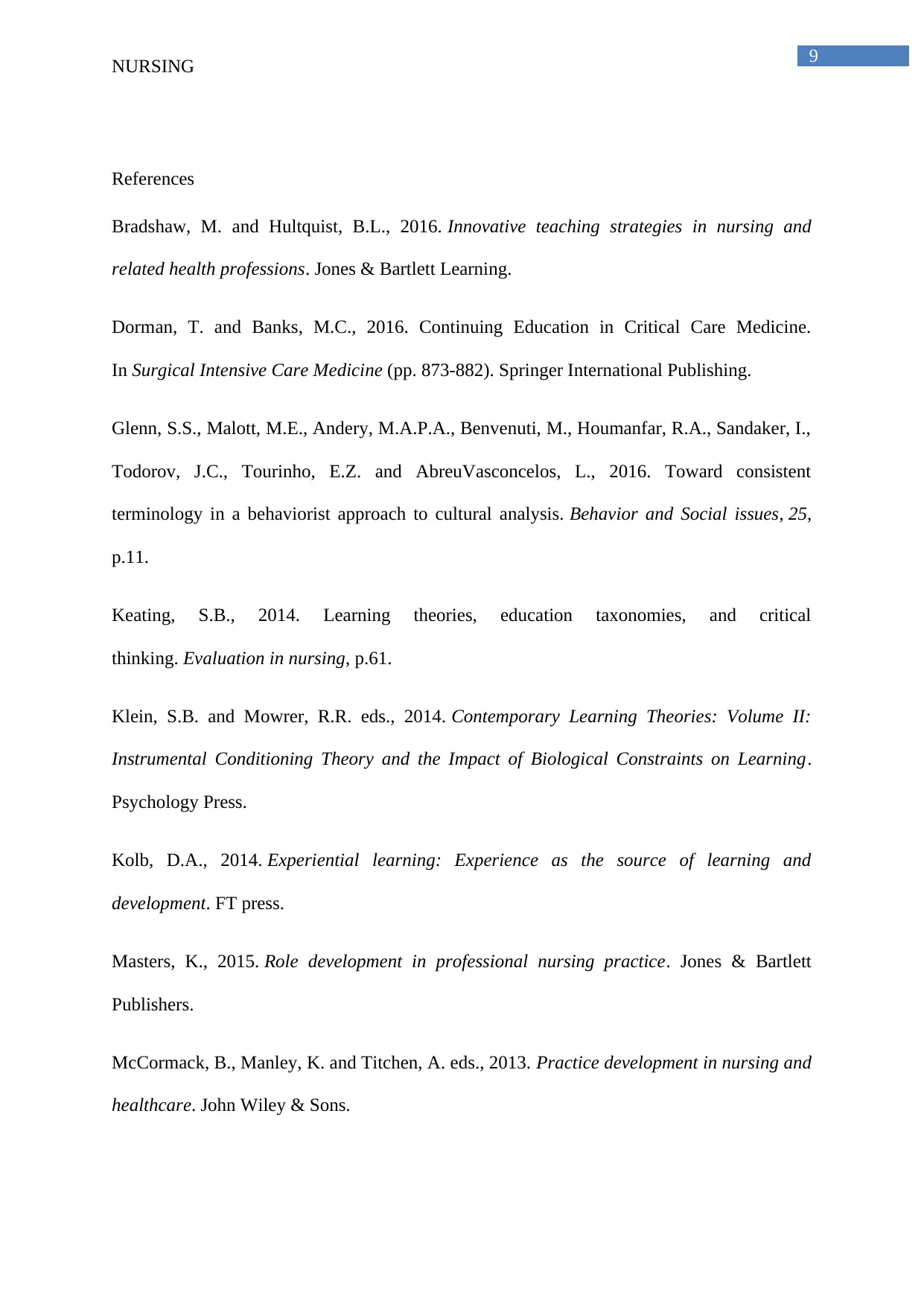
9
NURSING
References
Bradshaw, M. and Hultquist, B.L., 2016. Innovative teaching strategies in nursing and
related health professions. Jones & Bartlett Learning.
Dorman, T. and Banks, M.C., 2016. Continuing Education in Critical Care Medicine.
In Surgical Intensive Care Medicine (pp. 873-882). Springer International Publishing.
Glenn, S.S., Malott, M.E., Andery, M.A.P.A., Benvenuti, M., Houmanfar, R.A., Sandaker, I.,
Todorov, J.C., Tourinho, E.Z. and AbreuVasconcelos, L., 2016. Toward consistent
terminology in a behaviorist approach to cultural analysis. Behavior and Social issues, 25,
p.11.
Keating, S.B., 2014. Learning theories, education taxonomies, and critical
thinking. Evaluation in nursing, p.61.
Klein, S.B. and Mowrer, R.R. eds., 2014. Contemporary Learning Theories: Volume II:
Instrumental Conditioning Theory and the Impact of Biological Constraints on Learning.
Psychology Press.
Kolb, D.A., 2014. Experiential learning: Experience as the source of learning and
development. FT press.
Masters, K., 2015. Role development in professional nursing practice. Jones & Bartlett
Publishers.
McCormack, B., Manley, K. and Titchen, A. eds., 2013. Practice development in nursing and
healthcare. John Wiley & Sons.
NURSING
References
Bradshaw, M. and Hultquist, B.L., 2016. Innovative teaching strategies in nursing and
related health professions. Jones & Bartlett Learning.
Dorman, T. and Banks, M.C., 2016. Continuing Education in Critical Care Medicine.
In Surgical Intensive Care Medicine (pp. 873-882). Springer International Publishing.
Glenn, S.S., Malott, M.E., Andery, M.A.P.A., Benvenuti, M., Houmanfar, R.A., Sandaker, I.,
Todorov, J.C., Tourinho, E.Z. and AbreuVasconcelos, L., 2016. Toward consistent
terminology in a behaviorist approach to cultural analysis. Behavior and Social issues, 25,
p.11.
Keating, S.B., 2014. Learning theories, education taxonomies, and critical
thinking. Evaluation in nursing, p.61.
Klein, S.B. and Mowrer, R.R. eds., 2014. Contemporary Learning Theories: Volume II:
Instrumental Conditioning Theory and the Impact of Biological Constraints on Learning.
Psychology Press.
Kolb, D.A., 2014. Experiential learning: Experience as the source of learning and
development. FT press.
Masters, K., 2015. Role development in professional nursing practice. Jones & Bartlett
Publishers.
McCormack, B., Manley, K. and Titchen, A. eds., 2013. Practice development in nursing and
healthcare. John Wiley & Sons.
⊘ This is a preview!⊘
Do you want full access?
Subscribe today to unlock all pages.

Trusted by 1+ million students worldwide
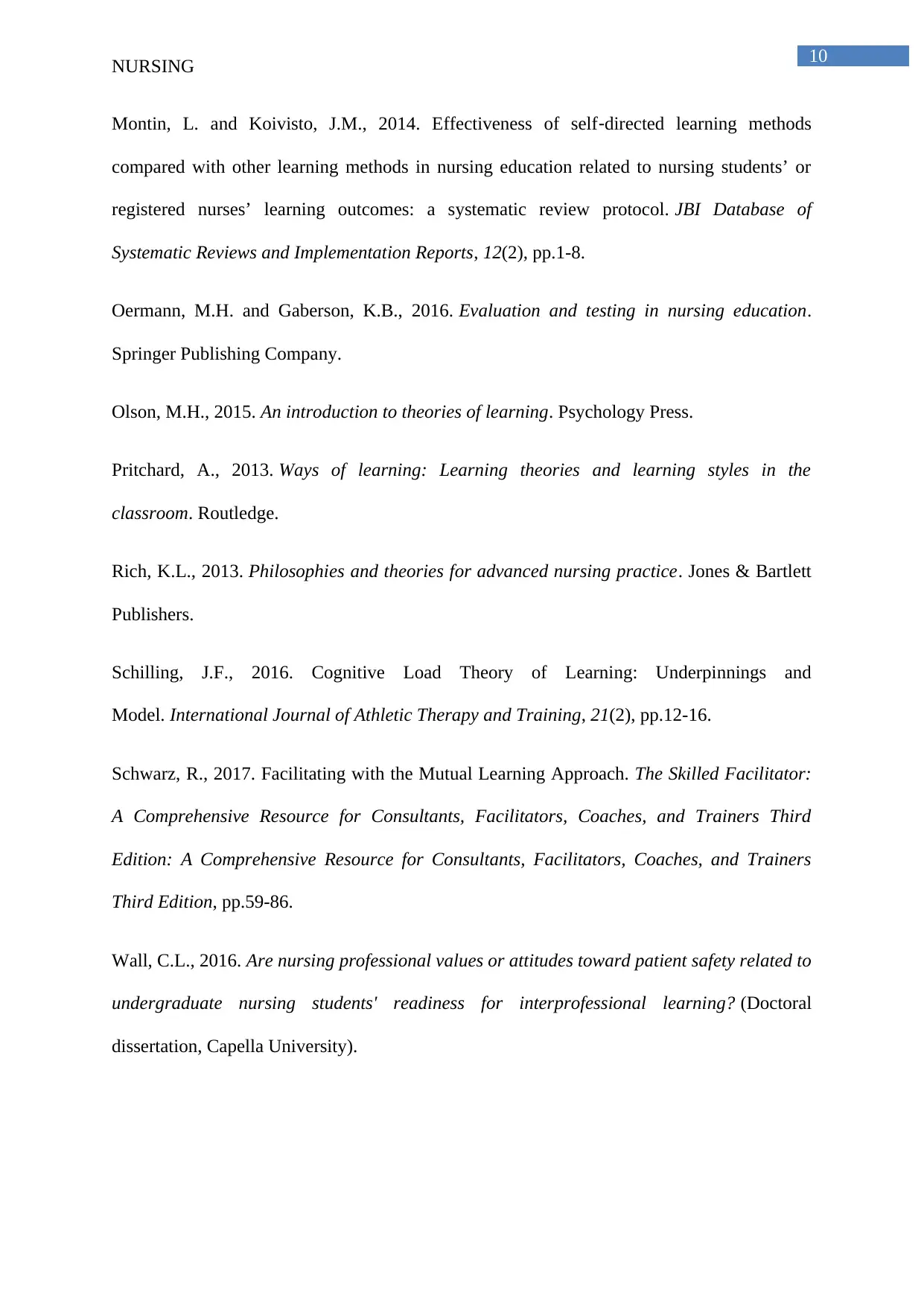
10
NURSING
Montin, L. and Koivisto, J.M., 2014. Effectiveness of self‐directed learning methods
compared with other learning methods in nursing education related to nursing students’ or
registered nurses’ learning outcomes: a systematic review protocol. JBI Database of
Systematic Reviews and Implementation Reports, 12(2), pp.1-8.
Oermann, M.H. and Gaberson, K.B., 2016. Evaluation and testing in nursing education.
Springer Publishing Company.
Olson, M.H., 2015. An introduction to theories of learning. Psychology Press.
Pritchard, A., 2013. Ways of learning: Learning theories and learning styles in the
classroom. Routledge.
Rich, K.L., 2013. Philosophies and theories for advanced nursing practice. Jones & Bartlett
Publishers.
Schilling, J.F., 2016. Cognitive Load Theory of Learning: Underpinnings and
Model. International Journal of Athletic Therapy and Training, 21(2), pp.12-16.
Schwarz, R., 2017. Facilitating with the Mutual Learning Approach. The Skilled Facilitator:
A Comprehensive Resource for Consultants, Facilitators, Coaches, and Trainers Third
Edition: A Comprehensive Resource for Consultants, Facilitators, Coaches, and Trainers
Third Edition, pp.59-86.
Wall, C.L., 2016. Are nursing professional values or attitudes toward patient safety related to
undergraduate nursing students' readiness for interprofessional learning? (Doctoral
dissertation, Capella University).
NURSING
Montin, L. and Koivisto, J.M., 2014. Effectiveness of self‐directed learning methods
compared with other learning methods in nursing education related to nursing students’ or
registered nurses’ learning outcomes: a systematic review protocol. JBI Database of
Systematic Reviews and Implementation Reports, 12(2), pp.1-8.
Oermann, M.H. and Gaberson, K.B., 2016. Evaluation and testing in nursing education.
Springer Publishing Company.
Olson, M.H., 2015. An introduction to theories of learning. Psychology Press.
Pritchard, A., 2013. Ways of learning: Learning theories and learning styles in the
classroom. Routledge.
Rich, K.L., 2013. Philosophies and theories for advanced nursing practice. Jones & Bartlett
Publishers.
Schilling, J.F., 2016. Cognitive Load Theory of Learning: Underpinnings and
Model. International Journal of Athletic Therapy and Training, 21(2), pp.12-16.
Schwarz, R., 2017. Facilitating with the Mutual Learning Approach. The Skilled Facilitator:
A Comprehensive Resource for Consultants, Facilitators, Coaches, and Trainers Third
Edition: A Comprehensive Resource for Consultants, Facilitators, Coaches, and Trainers
Third Edition, pp.59-86.
Wall, C.L., 2016. Are nursing professional values or attitudes toward patient safety related to
undergraduate nursing students' readiness for interprofessional learning? (Doctoral
dissertation, Capella University).
Paraphrase This Document
Need a fresh take? Get an instant paraphrase of this document with our AI Paraphraser
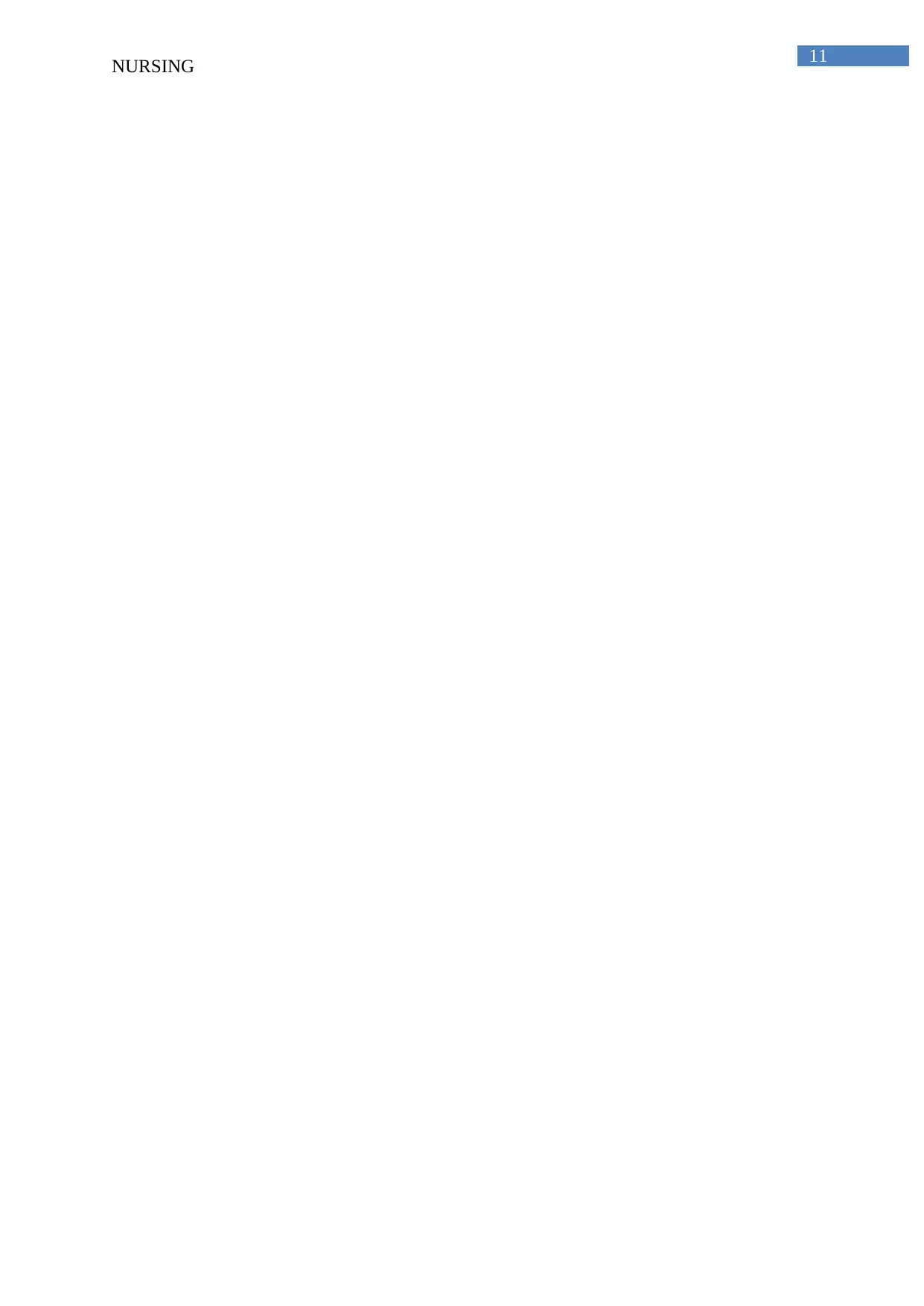
11
NURSING
NURSING
1 out of 11
Related Documents
Your All-in-One AI-Powered Toolkit for Academic Success.
+13062052269
info@desklib.com
Available 24*7 on WhatsApp / Email
![[object Object]](/_next/static/media/star-bottom.7253800d.svg)
Unlock your academic potential
Copyright © 2020–2025 A2Z Services. All Rights Reserved. Developed and managed by ZUCOL.





